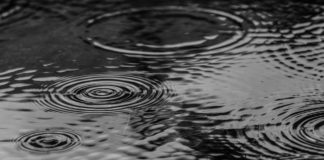The San Lorenzo River originates in the seeps and streams that form in the steep canyons and redwood forests above Boulder Creek. These ephemeral water sources run like tiny capillaries until their life force creates the river, the lungs of the watershed.
From a belt of Cenozoic rocks that range in age from 25 to 60 million years, the river runs a 25-mile, twisted route until it spills into the sands of Monterey Bay.
Before Europeans appeared on the scene, the headwaters, mostly in what is Castle Rock State Park today, served as temporary camps for the Achistaca people. Above the fog line and offering a spectacular view for hundreds of miles, the area was used by the tribe for hunting and gathering.
The Achistacas, who lived in what is now Boulder Creek, vanished with the arrival of “civilization” like other headwater inhabitants — the California grizzly bear, Mexican jaguar, California condor and coho salmon.
The river, as they knew it, vanished, too, as it was steadily degraded by logging, mining, road building, development, and failed septic systems.
Downstream in the city of Santa Cruz, the river wrote a different history. The riverbanks were mostly forest groves of willows, water maples, alders, laurels, elms, live oaks, cedars and redwoods.
In the 1870s, laws were created to protect the San Lorenzo from pollution, such as dumping industrial waste into the river, which suffocated fish. The river became a mecca for recreation and sports fishing.
The annual Venetian Water Carnivals, which featured decorated boat parades, began in 1895 and staged Gilbert and Sullivan operas on an island at the river’s bend.
During the 1920s and ’30s, a series of river beautification projects started, but in 1955, the San Lorenzo flooded Santa Cruz. Citizens’ view of the river changed from love to fear, and the Army Corps of Engineers was called in to strip the forests along the banks, straighten the river and turn it into a concrete canal.
But in 1970, a new sheriff came to town: Bruce Van Allen. Well, he was not a sheriff, but he would become mayor of Santa Cruz. The river, which had become as arid as the California Aqueduct, broke his heart.
He was determined to “take a stand and not despair.” During the next 40 years, Van Allen and his colleagues have worked to bring the natural heart back to the river.
In 2003, the Santa Cruz City Council adopted the San Lorenzo Urban Plan, written by a task force which Van Allen served on. The plan designates the levee trail system as “a recreational feature, an alternative transportation corridor, a fish and wildlife habitat and an amenity worthy of community support and involvement.”
His next goal is to reintroduce river festivals.
Van Allen will lead our last nature walk of the season on Oct. 2.
He likes to ask the question, “Where does your water come from?” If you live in Scotts Valley or the San Lorenzo Valley and you answered, “The San Lorenzo River,” you are incorrect. Do you know where the sand on the beach comes from? Do you know what is under the Pipe Line Trail in Cowell State Park?
Van Allen will answer these and other questions during our exploration of the river as he ties together the upper watershed with the river’s end in Santa Cruz. This is a free walk sponsored by the San Lorenzo Valley Water District. E-mail me for more information.
Carol Carson is an environmental activist and nature writer. She has been a docent at Henry Cowell Redwoods State Park and taught courses on Big Basin State Park for UCSC Extension. Contact her at ca****@*********on.com












